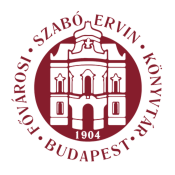Gábor Eszter: Andrássy Avenue – Our Budapest (Budapest, 2002)
The designer of the four buildings, Antal Szkalnitzky, is not to be blamed for the monotony. It was his employers, the Sugárút Construction Company, who insisted on uniformity — perhaps even identity — of appearance. With his two adjacent blocks of flats on Múzeum körút, the architect proved that he was fully capable of designing two buildings of a different character standing side by side. When mounted with neon signs, the four buildings ceased to be confusingly interchangeable. As testified by Hungarian films made in the 1930s, it was here that the first large neon signs of Budapest appeared. They may have been replaced with new ones since then, but the higher reaches of the facade are hidden behind these advertisements. The lower storeys were bustling with life. On the right was the famous Abbázia Café (No. 49 Andrássy út): "...thió became one of the largeót and mon luxurious buildings of Budapest with iti huge terrace, tropical plantó. Ailvety chandelien, huge wall mirron from Bruóóeló (allegedly the largest in the Dual Monarchy) and with table topó made 0^ oriental alabaster.” (Monumentó oi Catering by Imre Gundel and Judit Harmath.) It was here that the Independence Party politician and writer Károly Eötvös would meet his followers. (Eötvös was counsel for the defence who managed to achieve the acquittal of the unjustly charged defendants in the infamous 1883 'blood' trial of Jews from Tiszaeszlár, a case he would give an account of 20 years later in his three-volume work entitled The Great Trial that Began A Thousand $earó Ago and ló Still Not Finished.) After the turn of the century it was by the window that the table, visited by many, of lawyer Vilmos Vázsonyi stood. A regular at the Abbázia, Vázsonyi was a Democratic Party politician who served as minister of justice for a while. Across the square was the Nicoletti Café and later the famous Kovács Coffee House, another favourite with artists (No. 48 Andrássy út). It is here that his great battles of tarot are said to have been fought by sculptor György Zala, who lost, allegedly, his studio in István út at the game. The Nicoletti was superseded in the 1930s by the Savoy, a coffee house and restaurant with modern furniture. The two quality establishments of different characters complemented each other perfectly well. Both, however, met their nemesis. The Savoy was first turned into a stand-up fast-food outlet, later to be bought by Burger King. The Abbázia was updated into a self-service restaurant in the 1960s (at the time the wall behind the service counter was decorated with a mosaic by Tihamér Gyarmati), after another round of restorations (in the course of which Gyarmatis work was destroyed) it became the favourite haunt of illegal Arab money-changers and then, eventually, a bank. 3'
